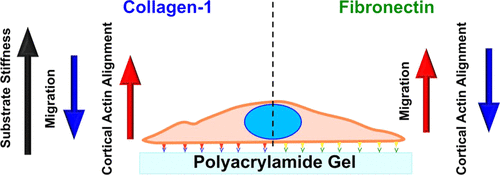当前位置:
X-MOL 学术
›
ACS Appl. Bio Mater.
›
论文详情
Our official English website, www.x-mol.net, welcomes your
feedback! (Note: you will need to create a separate account there.)
Extracellular Matrix Proteins and Substrate Stiffness Synergistically Regulate Vascular Smooth Muscle Cell Migration and Cortical Cytoskeleton Organization
ACS Applied Bio Materials ( IF 4.6 ) Pub Date : 2020-03-26 , DOI: 10.1021/acsabm.0c00100 Alex P Rickel 1 , Hanna J Sanyour 1 , Neil A Leyda 2 , Zhongkui Hong 1
ACS Applied Bio Materials ( IF 4.6 ) Pub Date : 2020-03-26 , DOI: 10.1021/acsabm.0c00100 Alex P Rickel 1 , Hanna J Sanyour 1 , Neil A Leyda 2 , Zhongkui Hong 1
Affiliation

|
Vascular smooth muscle cell (VSMC) migration is a critical step in the progression of cardiovascular disease and aging. Migrating VSMCs encounter a highly heterogeneous environment with the varying extracellular matrix (ECM) composition due to the differential synthesis of collagen and fibronectin (FN) in different regions and greatly changing stiffness, ranging from the soft necrotic core of plaques to hard calcifications within blood vessel walls. In this study, we demonstrate an application of a two-dimensional (2D) model consisting of an elastically tunable polyacrylamide gel of varying stiffness and ECM protein coating to study VSMC migration. This model mimics the in vivo microenvironment that VSMCs experience within a blood vessel wall, which may help identify potential therapeutic targets for the treatment of atherosclerosis. We found that substrate stiffness had differential effects on VSMC migration on type 1 collagen (COL1) and FN-coated substrates. VSMCs on COL1-coated substrates showed significantly diminished migration distance on stiffer substrates, while on FN-coated substrates VSMCs had significantly increased migration distance. In addition, cortical stress fiber orientation increased in VSMCs cultured on more rigid COL1-coated substrates, while decreasing on stiffer FN-coated substrates. On both proteins, a more disorganized cytoskeletal architecture was associated with faster migration. Overall, these results demonstrate that different ECM proteins can cause substrate stiffness to have differential effects on VSMC migration in the progression of cardiovascular diseases and aging.
中文翻译:

细胞外基质蛋白和基质硬度协同调节血管平滑肌细胞迁移和皮质细胞骨架组织
血管平滑肌细胞(VSMC)迁移是心血管疾病和衰老进展的关键步骤。由于不同区域胶原蛋白和纤连蛋白(FN)的合成差异以及硬度的巨大变化(从斑块的软坏死核心到血管内的硬钙化),迁移的VSMC会遇到高度异质的环境,细胞外基质(ECM)组成不同墙壁。在这项研究中,我们展示了二维 (2D) 模型的应用,该模型由不同硬度的弹性可调聚丙烯酰胺凝胶和 ECM 蛋白涂层组成,用于研究 VSMC 迁移。该模型模拟了 VSMC 在血管壁内经历的体内微环境,这可能有助于确定治疗动脉粥样硬化的潜在治疗靶点。我们发现基底刚度对 1 型胶原 (COL1) 和 FN 涂层基底上的 VSMC 迁移有不同的影响。 COL1 涂层基底上的 VSMC 在较硬的基底上表现出显着缩短的迁移距离,而在 FN 涂层基底上 VSMC 的迁移距离显着增加。此外,在更坚硬的 COL1 涂层基质上培养的 VSMC 中,皮质应力纤维方向增加,而在更坚硬的 FN 涂层基质上培养时,皮质应力纤维方向减少。在这两种蛋白质上,更混乱的细胞骨架结构与更快的迁移有关。总体而言,这些结果表明,不同的 ECM 蛋白可导致基质硬度对心血管疾病和衰老进展中的 VSMC 迁移产生不同的影响。
更新日期:2020-04-23
中文翻译:

细胞外基质蛋白和基质硬度协同调节血管平滑肌细胞迁移和皮质细胞骨架组织
血管平滑肌细胞(VSMC)迁移是心血管疾病和衰老进展的关键步骤。由于不同区域胶原蛋白和纤连蛋白(FN)的合成差异以及硬度的巨大变化(从斑块的软坏死核心到血管内的硬钙化),迁移的VSMC会遇到高度异质的环境,细胞外基质(ECM)组成不同墙壁。在这项研究中,我们展示了二维 (2D) 模型的应用,该模型由不同硬度的弹性可调聚丙烯酰胺凝胶和 ECM 蛋白涂层组成,用于研究 VSMC 迁移。该模型模拟了 VSMC 在血管壁内经历的体内微环境,这可能有助于确定治疗动脉粥样硬化的潜在治疗靶点。我们发现基底刚度对 1 型胶原 (COL1) 和 FN 涂层基底上的 VSMC 迁移有不同的影响。 COL1 涂层基底上的 VSMC 在较硬的基底上表现出显着缩短的迁移距离,而在 FN 涂层基底上 VSMC 的迁移距离显着增加。此外,在更坚硬的 COL1 涂层基质上培养的 VSMC 中,皮质应力纤维方向增加,而在更坚硬的 FN 涂层基质上培养时,皮质应力纤维方向减少。在这两种蛋白质上,更混乱的细胞骨架结构与更快的迁移有关。总体而言,这些结果表明,不同的 ECM 蛋白可导致基质硬度对心血管疾病和衰老进展中的 VSMC 迁移产生不同的影响。











































 京公网安备 11010802027423号
京公网安备 11010802027423号